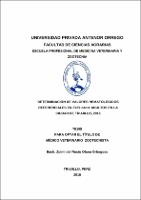Determinación de valores hematológicos referenciales en Felis catus adultos en la ciudad de Trujillo, 2016

View/
Download
(application/pdf: 637.0Kb)
(application/pdf: 637.0Kb)
Date
2019Author(s)
Olano Orbegoso, Zulmi del Rocio
Metadata
Show full item recordAbstract
Hasta la actualidad, en la ciudad de Trujillo, no se han realizado
investigaciones para determinar los valores hematológicos de referencia
para los gatos domésticos; motivo que ha impulsado realizar la presente
investigación en Felis catus adultos clínicamente sanos; la misma que es,
de carácter descriptivo, tuvo un periodo de duración de cuatro meses y fue
ejecutada en cinco consultorios veterinarios: Centro Médico Veterinario ““Mi
Mascota””, Centro Veterinario ““Orvet””, Centro Veterinario ““Canes clínica
veterinaria y resort”” , Centro Médico Veterinario ““San Martin”” y
Veterinaria ““Can y Fel””. Se evaluaron 80 Felis catus adultos clínicamente
sanos, de ambos sexos, de diversas razas, con la finalidad de determinar
los valores hematológicos. Los pacientes que intervinieron en el presente
estudio, fueron evaluados clínicamente para determinar que se encuentren
sanos. Las muestras sanguíneas fueron obtenidas de la vena cefálica
mediante la aséptica debida , a través del uso del sistema al vacío y tubos
con EDTA, obteniéndose en promedio 2 ml de sangre venosa, la misma
que fue homogenizada inmediatamente después de la toma y remitida al
laboratorio para la realización del hemograma completo automatizado,
mediante el uso del hemocitómetro de uso veterinario, usando la tecnología
de impedancia eléctrica, obteniéndose los tres diferenciales celulares,
constando de serie roja, serie plaquetar y serie blanca. En la serie roja se
evaluaron el recuento de glóbulos rojos (mill/dL), la hemoglobina (mg/dL),
el hematocrito (%), el volumen corpuscular medio (fL), la hemoglobina
corpuscular media (pg), la concentración de hemoglobina corpuscular
media (mg/dL). La serie plaquetaria expresado en miles por decilitro (mil/
dL). En el recuento de glóbulos blancos (G.B), neutrófilos bastonados,
neutrófilos segmentados, linfocitos, eosinófilos, monocitos y basófilos
expresados en miles por decilitro (mil/ dL). Los resultados del hemograma
permitieron obtener datos cuantitativos y cualitativos para todas las series
mencionadas. Up to now in the city of Trujillo there have been no investigations to
determine the reference hematological values for domestic cats; motive that
has impelled to realize the present investigation in Felis catus adults
clinically healthy, the same that is of descriptive character, had a period of
duration of four months and was executed in five veterinary offices:
Veterinary Center ““Mi Mascota””, Veterinary Center ““Orvet””; Veterinary
““Center Canes veterinary clinic and resort”” , Veterinary Medical Center
““San Martin”” and Veterinary ““Can and Fel””. We evaluated 80 clinically
healthy Felis catus adults, of both sexes, of different races, in order to
determine the reference hematological values. All the patients who
participated in the present study were evaluated clinically to determine that
they are healthy.The blood samples were obtained by venopuction of the
cephalic vein by aseptic technique, by means of the use of vacuum system
and tubes with EDTA, obtaining on average 2 ml of venous blood, the same
that was homogenized immediately after taking and sent to the laboratory
for the realization of the automated complete blood count, by means of the
use of the hemocytometer for veterinary use, using the electrical impedance
technology, obtaining the three cellular differentials, consisting of red series,
platelet series and white series. In the red series, the red blood cell count
(mill/dL), the hemoglobin (mil/dL), the hematocrit (%), mean corpuscular
volume (fL), the mean corpuscular hemoglobin (pg) and the mean
corpuscular hemoglobin concentration were evaluated. (mg/dL). The
plaquetary series expressed in thousands per deciliter (mil /dL). In the count
of white blood cells (WBC), bast neutrophils, segmented neutrophils,
lymphocytes, eosinophils, monocytes and basophils expressed in
thousands per deciliter (mil / dL). The results of the blood count allowed to
obtain quantitative and qualitative data for all the series mentioned.
Subject
Collections
- Veterinaria y Zootecnia [197]

